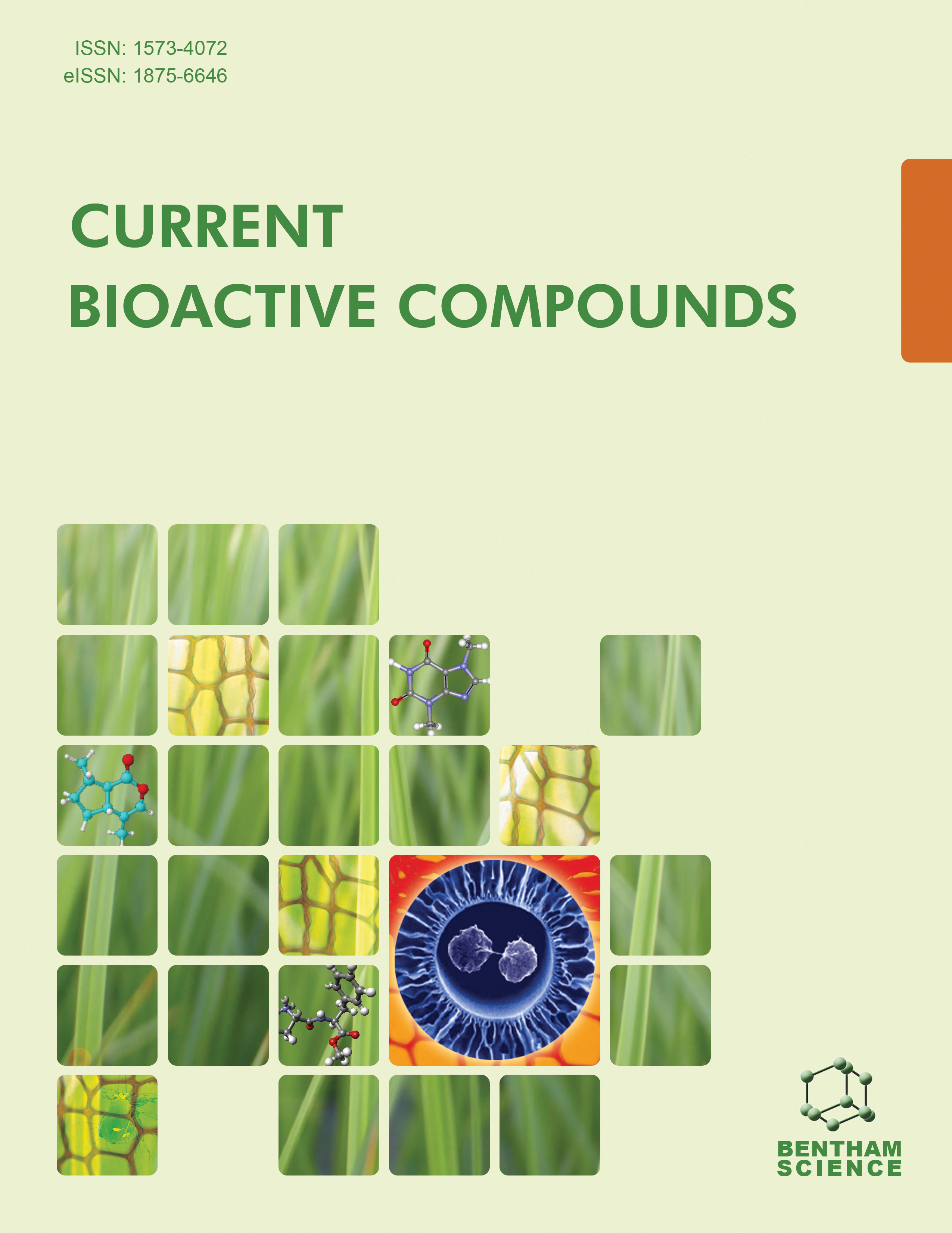- Home
- A-Z Publications
- Current Bioactive Compounds
- Previous Issues
- Volume 18, Issue 5, 2022
Current Bioactive Compounds - Volume 18, Issue 5, 2022
Volume 18, Issue 5, 2022
-
-
A Review on Bioactive Constituents of Essential Oils as Mosquito Repellent
More LessAuthors: Rajat S. Dutta, Supriya Sahu and Bhaskar MazumderCurrently, the research focus has been on finding new alternatives to synthetic mosquito repellents due to their toxicity. Natural products act as a suitable alternative since plant-based mosquito repellents have been used traditionally due to their low toxicity. Essential oils as mosquito repellent have gained importance due to various functional bioactive constituents. Different formulations of essential oils have been studied from Read More
-
-
-
Therapeutic Benefits of Piper nigrum: A Review
More LessAuthors: Banishree Majumdar, Rishabha Malviya and Akanksha SharmaThis manuscript aims to describe the various pharmacological activities of Piper nigrum. Pepper is a common spice of the plant which is used as spice in preparation of various foods. Pepper production is centered in Kerela, followed by Karnataka and Maharashtra in India. Other big pepper-producing countries include Indonesia, Malaysia, Brazil, Vietnam, and Sri Lanka. It has various pharmacological activities which is why it i Read More
-
-
-
Kolaviron, A Biflavonoid Compound: Its Pharmacological Activity and Therapeutic Efficacy
More LessThe use of herbal remedies for medicinal purposes is becoming more popular around the world. As a result, plants have become viable treatment options for a variety of diseases. Garcinia kola (bitter kola) is a perennially grown plant in the Guttiferae family that has been evaluated and reported to have numerous health-promoting properties. Kolaviron is a biflavanoid and major phytochemical found in Garcinia kola that i Read More
-
-
-
Phytoconstituents of Lantana camara L.: Rekindling Hope in the Cancer Treatment
More LessAuthors: Ishita Kathuria, Mit Joshi, Bhoomika M. Patel and Mahaveer DhobiBackground: Lantana camara L. belongs to the family Verbenaceae. It originated in Tropical America in Southern Georgia and the North of Texas, and was introduced in Calcutta, India, in the year 1809 as an ornamental hedge. The plant L. camara is also distributed in Southeast Asia, China, Australia, Brazil, West Indies, Kenya, Mexico, East Africa, and Tanzania. Many of its phytoconstituents possess medicinal properties which Read More
-
-
-
Iridoids Analysis by Different Analytical Techniques and its Role as Pharmacologic Agents: A Review
More LessAuthors: Rishabh Verma, M. F. Arshad, Parul Grover, Jasmeet Kaur, Neha Gandhi, Vishnu Das and Mohamad TaleuzzamanIridoids are monoterpenoids classed with a cyclopentanopyran framework and detected in various plants and certain special animals. In plants, it exists as glycosides, generally bound to glucose. Around six hundred iridoid glycosides are available in fifty-seven families of plants. Iridoids are abundant in dicotyledonous plants belonging to the Diervillaceae, Loganiaceae, Apocynaceae, Scrophulariaceae, Lamiaceae, and Rubiac Read More
-
-
-
Synthesis, Biological Screening and Docking Study of Some Novel Pyrazolopyrano[ 2,3-B]quinolin Derivatives as Potent Antibacterial Agents
More LessAuthors: Hamideh Emtiazi, Ali S. Sharif and Mina ArdestaniBackground: Pyranopyrazoles have a variety of biological activities and can be obtained by various starting materials and synthetic methods. Also, pyrazolopyrano[2,3-b]quinolins that contain pyranopyrazole moiety have some biological activities such as anti-acetylcholinesterase and anti-butyrylcholinesterase activity. In this research, our objective is to prepare pyranopyrazole compounds and pyrazolopyrano[2,3-b]quinolin Read More
-
-
-
Contribution of Organic Bee Pollen to the Determination of Botanical Origin of Honey and its Impact on its Biological Properties
More LessBackground: Honey is a sweet and flavorful natural product that comes from a lot of nectar of medicinal plants. Objective: This study aimed to determine the botanical origin, physicochemical parameters, antioxidant contents, and antibacterial activities of Algerian honey. Methods: The physicochemical parameters of the honey analyzed were measured using the methods established by the European Honey Commission. Read More
-
Volumes & issues
-
Volume 21 (2025)
-
Volume 20 (2024)
-
Volume 19 (2023)
-
Volume 18 (2022)
-
Volume 17 (2021)
-
Volume 16 (2020)
-
Volume 15 (2019)
-
Volume 14 (2018)
-
Volume 13 (2017)
-
Volume 12 (2016)
-
Volume 11 (2015)
-
Volume 10 (2014)
-
Volume 9 (2013)
-
Volume 8 (2012)
-
Volume 7 (2011)
-
Volume 6 (2010)
-
Volume 5 (2009)
-
Volume 4 (2008)
-
Volume 3 (2007)
-
Volume 2 (2006)
-
Volume 1 (2005)
Most Read This Month
Article
content/journals/cbc
Journal
10
5
false
en

Most Cited Most Cited RSS feed
-
-
Podophyllotoxin: Current Perspectives
Authors: Ying Qian Liu, Liu Yang and Xuan Tian
-
- More Less

